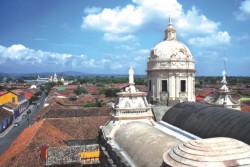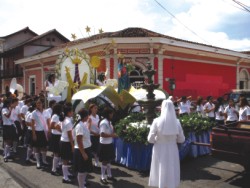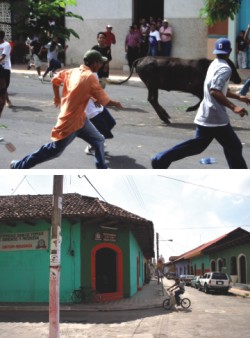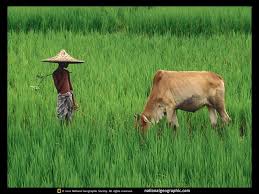The Hippo at my Door!
 |
When the shore is coloured Flamingo Pink. |
'A zoo in My Luggage”, like that of Gerald Durrell's, would have been quite unnecessary here in the land of the Masai Mara. One need only look out one's cabin window. I am surrounded by the dusty yellowness of the Kenyan grasslands, broken from the pale blue sky by the bluish green of distant hills. The area where my log cabin is situated is monkey territory by day, occasionally overrun by tiny electric blue birds and odd, colourful lizards. Things, however, are different at night.
All sorts of things take place after dark. The dining hall of the safari resort, a grand affair with trophy heads and African wooden sculptures, is a two-minute walk from my cabin. We are deeply engrossed in consuming stir-fried beef, followed by chocolate pudding, when one of the Masai guards approaches us. Are we the occupants of cabin 72? It turns out we are. Apparently two hippopotamuses have taken up dining on the grass in front of our cabin and would we be kind enough not to disturb them on our way back?
 |
King of the grasslands? |
The walk back to our cabin is a thrilling yet scary venture, but we take courage in the fact that our guard is a traditional Masai warrior who claims to have killed two lions with spears in his lifetime. Not that the hippopotamuses would attack us. The only animals with potential danger are the rhino, with their horns and unpredictable temper, especially the strong, aggressive buffalo. The hippo, when viewed from the back, is rather comical, with its huge behind and tiny, twig-like legs. The very fact that it was even there was not a matter of surprise. Since the hotel is really a bunch of log cabins right in the middle of the grasslands, with no boundaries whatsoever, animals come and go.
Brushing my teeth before bed, I watch my mother take her customary walk at night, quite oblivious to the giant owls interrupting her every now and then. When standing, they look more like land animals than birds, large as they are. One comes up well above her waist.
Bedtime, however, is postponed, with a pack of lions suddenly coming into our camp. They first make their appearance in the opening behind our cabin. Following the shouts of fellow cabin dwellers, we look out through the glass wall, and with the aid of a torch behold two lions followed by their lionesses. Since lions are alpha male and lazy by nature, such collaborations between two or more males and their lionesses are rare. They must be out on an important kill, we deduce. Soon enough, our Masai guard informs us that they had come in search of those very hippos which had been grazing happily in front of our cabin! Luckily, they had sensed danger and left some time back.
Our exposure to the Masai people is not just limited to our guards. Heavily ornamented women dressed in red from the local tribes often come to the hotels to sell handcrafted bead jewellery. Their trademark ear piercings are large enough to pass bamboo canes through. That night we are visited by tall Masai men who perform their traditional dance. The highest a man can jump during the dance, the better his chances are of attracting a mate.
At dawn we wake up to a cool grassland morning. A quick visit to the hotel's resident hippos finishes our early morning tea and we are off on our safari with a jeep and an icebox full of ginger ale.
Here in the midst of the great African Rift Valley, one has to re-learn the laws of nature. The lion, apparently, is not king of the jungle because:
1. Lions do not live in jungles, they live in grasslands.
2. They, too, live in fear of other animals. A mighty kick from an adult giraffe could send a lion flying, literally.
3. Unlike popular belief, lions do not eat human beings because, as my guide insisted, our meat does not taste good to them. Oddly enough, I felt insulted.
There are other lessons to learn too. When we watch a zebra save its child from an attack of a cheetah on TV we cheer for it, but here in the reality of things the harshness of it does not cease there, as it only means that that cheetah and her cubs will go hungry that day, and may even die.
 |
Smart in stripes. |
The lions are not hard to find, but the cheetahs are, being loners by nature. It's really all National Geographic, only you are in the TV set. Graceful giraffes, wild elephants, wildebeests, zebras and hyenas move in packs, herds and groups They all completely ignore us humans, all except a small dikdik (tiny deer) that suddenly appears from a small bush, looks up startled, and then disappears.
The grass is drying up and only a few days back millions of wildebeests had made their legendary annual crossing over the valley between Kenya and Tanzania. Now all there is left there is the overpowering stench of the carcasses, thousands of them, of the ones who did not make the brutal crossing of the steep valley, populated with alligators and vultures who wait the whole year to feast on them.
We had earlier been introduced to some of these animals in Nairobi. We visited an elephant orphanage where a baby elephant, colourfully attired in red, stole the show for us. There was also the charming estate of Baroness Karen von Blixen-Finecke of the 'Out of Africa' fame, part of which is now conserved for the protection of giraffes. For a small fee you can feed the giraffes from a tower.
Quite a few hours drive away from Nairobi is the Flamingo Park with a lake which boasts the highest concentration of flamingos in the world. Viewed from a hilltop, the shores are lined with flamingo pink. Viewed close up, the brilliant sight is juxtaposed with the overpowering stench of bird droppings, but the adventurous soul gets used to it after some time. There are also baboons, those tiny electric blue birds as well as others I cannot name. The highlight of the tour, though, was a rhino couple peacefully napping under a tree.
We left the same way we came- in a whirlwind of dust kicked up by the wheels in the wake of our jeep. I looked back to get one last look and before I turned back I glimpsed, just for a fleeting second, a little dikdik's head peeking out from behind a roadside bush.
















